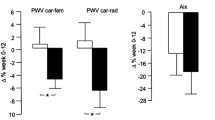Summary
Carvedilol is a potent antihypertensive agent with a dual mechanism of action. At relatively low concentrations it is a competitive β-adrenoceptor antagonist and a vasodilator, whereas at higher concentrations it is also a calcium channel antagonist. The antihypertensive activity of carvedilol is characterized by a decrease in peripheral vascular resistance, resulting from the vasodilator activity of the compound, with no reflex tachycardia, as a result of β-adrenoceptor blockade. The antihypertensive activity of carvedilol is associated with an apparent “renal sparing” effect in that the reduction in mean arterial blood pressure does not compromise renal blood flow or urinary sodium excretion. Studies on the mechanism of action of carvedilol indicate that the compound is a potent competitive antagonist of β1- and β2-adrenoceptors with a dissociation constant (KB) of 0.9 nM at both β-adrenoceptor subtypes. Carvedilol is also a potent α1-adrenoceptor antagonist (KB = 11 nM), which accounts for most, if not all, of the vasodilating response produced by the compound. At concentrations above 1 μM, carvedilol is a calcium channel antagonist. This activity can be demonstrated in vivo at doses that represent the higher end of the anti-hypertensive dose-response curve. Although the calcium-channel blocking activity of carvedilol may not contribute to the antihypertensive activity of the compound, it may play a prominent role in certain peripheral vascular beds, such as the cutaneous circulation, where marked increases in blood flow are observed. The data indicate that carvedilol is an antihypertensive agent that is both a β-adrenoceptor antagonist and a vasodilator. The vasodilating activity of carvedilol results largely from α1-adrenoceptor blockade, and its β-adrenoceptor blocking activity prevents reflex tachycardia. In some regional vascular beds, such as the cutaneous circulation, the calcium-channel blocking activity of carvedilol may be responsible for increasing the blood flow.
Similar content being viewed by others
References
Arunlakshana O, Schild HO (1959) Some quantitative uses of drug antagonism. Br J Pharmacol 14: 45–58
Eggertsen R, Sivertsson R, Andren L, Hansson L (1987) Acute and long-term hemodynamic effects of carvedilol, a combined betaadrenoceptor blocking and precapillary vasodilating agent, in hypertensive patients. J Cardiovasc Pharmacol 10 [Suppl 11]: 97–100
Nichols AJ, Ruffolo RR Jr (1988) The relationship of a-adrenoceptor reserve and agonist intrinsic efficacy to calcium utilization in the vasculature. Trends Pharmacol Sci 9: 236–241
Rodeheffer RJ, Rommer JA, Wigley F, Smith CR (1983) Controlled double-blind trial of nifedipine in the treatment of Raynaud's phenomena. N Engl J Med 308: 880–883
Ruffolo RR Jr (1982) Important concepts of receptor theory. J Auton Pharmacol 2: 277–295
Ruffolo RR Jr (1984) Stereochemical requirements for activation and blockade of alpha-1 and alpha-2 adrenoceptors. Trends Pharmacol Sci 5: 160–164
Ruffolo RR Jr (1987) The pharmacology of dobutamine. Am J Med Sci 294: 244–248
Ruffolo RR Jr (1988) Cardiovascular adrenoceptors: physiology and critical care implications. In: Chernow B (ed) The pharmacologic approach to the critically ill patient. Williams and Wilkins, Baltimore, pp 166–183
Seki N, Nagao T, Komori K, Suzuki H (1988) Alpha- and betaadrenoceptor blocking action of carvedilol in the canine mesenteric artery and vein. J Pharmacol Exp Ther 246: 1116–1122
Smith CD, McKendry RJR (1982) Controlled trial of nifedipine in the treatment of Raynaud's phenomenon. Lancet II: 1299–1301
Sponer G, Strein K, Muller-Beckmann B, Bartsch W (1987) Studies on the mode of vasodilating action of carvedilol. J Cardiovasc Pharmacol 10 [Suppl 11]: 42–48
Strein K, Sponer G, Muller-Beckmann G, Bartsch W (1987) Pharmacological profile of carvedilol, a compound with beta-blocking and vasodilating properties. J Cardiovasc Pharmacol 10 [Suppl 11]: 33–41
Sundberg S, Tiihonen K, Gordin A (1987) Vasodilatory effects of carvedilol and pindolol. J Cardiovas Pharmacol 10 [Suppl 11]: 76–80
Author information
Authors and Affiliations
Rights and permissions
About this article
Cite this article
Ruffolo, R.R., Gellai, M., Hieble, J.P. et al. The pharmacology of carvedilol. Eur J Clin Pharmacol 38 (Suppl 2), S82–S88 (1990). https://doi.org/10.1007/BF01409471
Issue Date:
DOI: https://doi.org/10.1007/BF01409471




